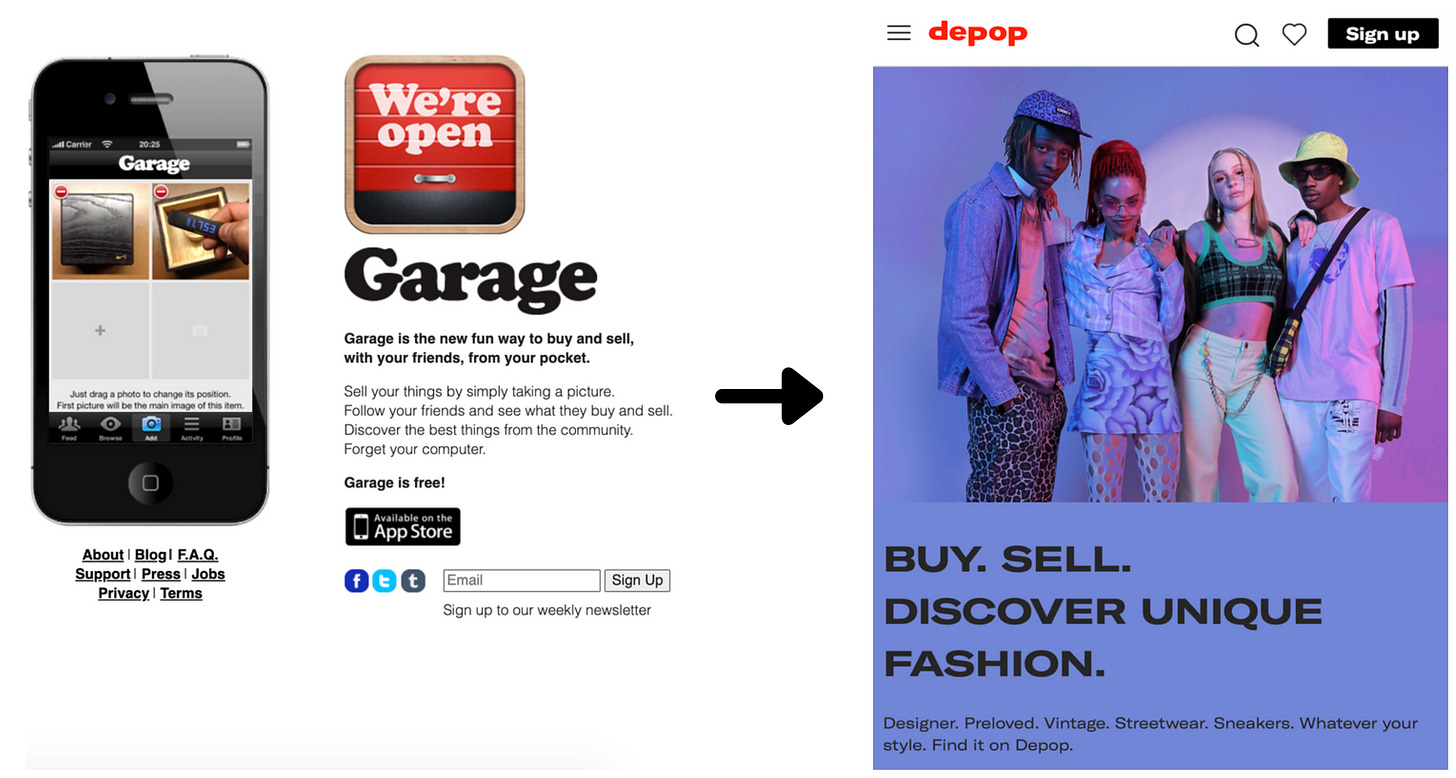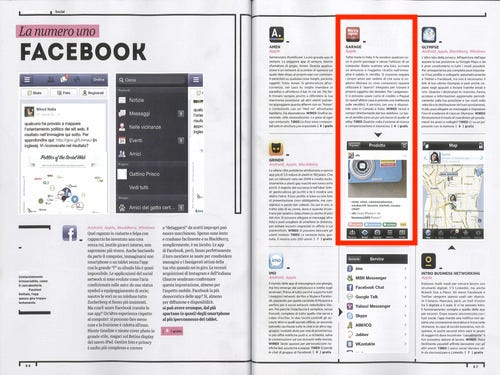🎆 Depop: Inside the rise of Gen Z's favorite resale app
And what marketplaces can learn about how to get the "flywheel" going!
“Another day, another social mobile shopping app.” So began TechCrunch’s coverage of Depop’s $1 million seed round in October 2013.
The resale space was saturated when Depop launched its “garage sale” app. eBay and Craigslist owned the market, and dozens of upstarts were in fierce competition to carve out niches. Sure, Poshmark and GOAT are still around today - but have you heard of Stuffle, Rumgr, Vendly, Yardsale, or Osom?
Depop wasn’t a likely winner. Founder Simon Beckerman was a graphic designer who had started a sunglasses brand and cultural magazine. He founded Depop, originally called Garage, as an extra revenue stream for said magazine! And the company first launched in Italy, a market that flew under the radar of Silicon Valley investors.
Fast forward nine years, and the narrative around Depop has completely changed. It’s now Gen Z’s favorite fashion resale app - having a Depop store is a status symbol among teen girls, who use it like a social network. One in every three UK teens is on Depop, and the site ranks in the top ten for U.S. Gen Zers.
With 30M users worldwide and $650M in 2020 GMV, Depop is unquestionably a massive success. When the company was acquired by Etsy for $1.6B earlier this year, Etsy CEO Josh Silverman told CNBC that Depop was an “organic, authentic phenomenon” - growing 100%+ YoY with no real marketing spend.
And it all started with the company’s launch! How did Depop break out in a crowded space, reaching 100k users in its first year? Three lessons marketplaces can learn from Depop’s debut 👇
1️⃣ Go where no one else is. How many unicorns start in Italy? It’s not a common market for VC-backed businesses, but it gave Depop a competitive advantage.
In Italy, Depop was a big fish in a small pond. Shortly after launching its beta, the company was profiled in Glamour Italy and in dozens of Italian tech and commerce blogs. A few months post-launch, Depop even made Wired Italia’s “100 Best Apps of 2012” list - right next to Facebook!
This kind of distribution is like rocket fuel for an early stage marketplace. Liquidity is crucial, which means the marketplace needs a steady (and proportional) flow of supply and demand to make matches. Getting this flywheel going can be difficult, but millions of organic impressions makes it much easier - especially if you don’t have to fight well-funded competitors for consumer attention.
By the time Depop launched in its second market (the UK), the app had a base of 50k registered users to build from. More importantly, Depop had seven listed items per user, which was a good sign for the marketplace’s health. Users weren’t just posting one item and churning - using Depop was becoming a repeat behavior!
2️⃣ Do things that don’t scale. Though Depop is known for P2P transactions, the team wasn’t afraid to seed the market with a different type of supply.
Before the UK launch, Depop onboarded a number of independent clothing stores, who agreed to upload their inventory to the app. This solved the “cold start” problem - consumers who downloaded Depop could immediately browse and buy quality items. Working with smaller stores created a true “win-win,” as these shops benefitted from a new distribution channel.
This later expanded into partnerships with influencers known for their giant closets - Chiara Ferragni opened her Depop shop in March 2014, which is still active today! (Seven years later, Depop’s partnerships with influencers and brands remains core to buyer growth. Most recently, Gen Z 👑 Olivia Rodrigo offered items from her music video wardrobes + personal closet in her own Depop store.)
While most of these small shops and creators didn’t individually drive substantial revenue, they signaled Depop’s ambitions and interest in fashion to serious potential sellers and buyers. This wouldn’t be a “race to the bottom” marketplace where sellers competed on price alone, but somewhere to offer unique items with a story.
3️⃣ Drive engagement beyond transactions. The most valuable marketplaces aren’t just a place to buy and sell products - they become a destination for users to spend time. If you’re a marketplace founder, ask yourself this: even if a consumer doesn’t plan on transacting, will they still get value from opening your app?
Depop nailed this from the very beginning. TechCrunch described the app as “part Instagram-style social network and part eBay marketplace.” Take a look at the screenshots - the feed, comments, and profiles are reminiscent of a social app.
This made Depop “sticky.” The app was a fun place to browse and connect - users would seek inspiration and follow or talk to others with aesthetics they admired. In November 2013, COO Runar Reistrup said Depop’s 120k users had generated 13M likes and 18M follows, and were sending 50k messages per day. These users were “almost as likely” to come to Depop to talk as they were to transact.
Fun fact: The earliest version of Depop actually de-emphasized transactions. A buyer and seller had to converse before the seller activated the “sell” button, which would allow the buyer to purchase the item.
This is part of what makes Depop so popular among Gen Z. Many younger consumers have limited purchasing power, but see Depop as a place to browse items and save aspirational content - like Pinterest. And when they’re ready to make a purchase, Depop is the natural place to do it.
Thanks for reading! I’d love to hear your feedback or requests for companies you’d like me to profile next - you can reach me @omooretweets.
My sources:
“Social shopping app Depop raises $8M” - Ingrid Lunden
“About Depop” - Simon Beckerman
“How did Depop get a cult following of 15 million active users?” - Shweta Singh
“Hugo Boss board member backs social shopping app Depop” - Hunter Ruthven
“Depop is another flea market for iOS but also has sights firmly set on Etsy” - Steve O’Hear
“Pitch - Depop - NOAH13” - Simon Beckerman, Runar Reistrup
All views are my own. None of the above should be taken as investment advice. See this page for important information.








read all the articles, they're very well written & crisp! i love the 3 takeaways at the bottom as they have really great insights. would love if you can cover opensea/looksrare on how they solve the cold start problem! and maybe indian/chinese crossover as some of them have nice stories (see dukaan/pinduoduo) but would love your takeaways!